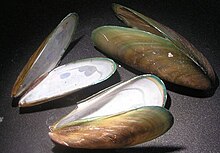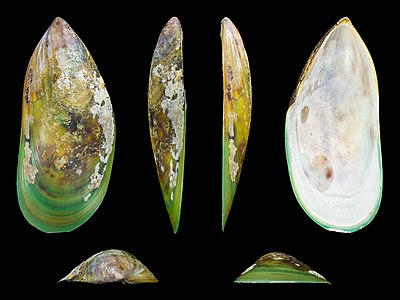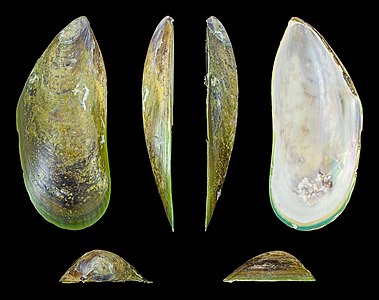
Biofouling or biological fouling is the accumulation of microorganisms, plants, algae, or small animals where it is not wanted on surfaces such as ship and submarine hulls, devices such as water inlets, pipework, grates, ponds, and rivers that cause degradation to the primary purpose of that item. Such accumulation is referred to as epibiosis when the host surface is another organism and the relationship is not parasitic. Since biofouling can occur almost anywhere water is present, biofouling poses risks to a wide variety of objects such as boat hulls and equipment, medical devices and membranes, as well as to entire industries, such as paper manufacturing, food processing, underwater construction, and desalination plants.

Mytilopsis sallei, the black-striped mussel, is a small marine bivalve mollusc in the family Dreissenidae, the false mussels.

Perna canaliculus, the New Zealand green-lipped mussel, also known as the New Zealand mussel, the greenshell mussel, kuku, and kutai, is a bivalve mollusc in the family Mytilidae. P. canaliculus has economic importance as a cultivated species in New Zealand.
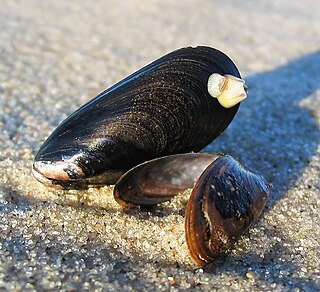
Mytilidae are a family of small to large marine and brackish-water bivalve molluscs in the order Mytilida. One of the genera, Limnoperna, even inhabits freshwater environments. Mytilidae, which contains some 52 genera, is the only extant family within the order Mytilida.

Perna perna, the brown mussel, is an economically important mussel, a bivalve mollusc belonging to the family Mytilidae. It is harvested as a food source but is also known to harbor toxins and cause damage to marine structures. It is native to the waters of Africa, Europe, and South America and was introduced in the waters of North America.

Lithophaga lithophaga, also known as date shell or date mussel, is a species of Bivalvia belonging to the family Mytilidae.

Mytilopsis leucophaeata is a species of small bivalve mollusc in the false mussel family, Dreissenidae. It is commonly known as Conrad's false mussel or the dark false mussel.

Choromytilus meridionalis, the black mussel, is a species of bivalve. It is a marine mollusc in the family Mytilidae. They are part of the family Mollusca which is the second-largest phylum of invertebrates with around 85,000 species. In this article, we will be discussing the taxonomy, morphology, ecology, reproduction, and distribution of Choromytilus meridionalis.

Geukensia demissa is a species of mussel, a marine bivalve mollusk in the family Mytilidae, the true mussels. This species is native to the Atlantic coast of North America. The common names for this species include ribbed mussel, Atlantic ribbed marsh mussel and ribbed horsemussel. However, the common name ribbed mussel is also used for the Southern Hemisphere mussel Aulacomya atra. The appearance of the shell is grooved and oval in shape. The interior of this mussel is tinted purple

Perna is a genus of mussels, marine bivalve molluscs in the family Mytilidae.

Ulva linza is a green alga in the family Ulvaceae that can be found in British Isles.

Limnoperna fortunei, the golden mussel, is a medium-sized freshwater bivalve mollusc of the family Mytilidae. The native range of the species is China, but it has accidentally been introduced to South America and several Asian countries where it has become an invasive species. It is considered to be an ecosystem engineer because it alters the nature of the water and the bottom habitats of lakes and rivers and modifies the associated invertebrate communities. It also has strong effects on the properties of the water column, modifying nutrient proportions and concentrations, increasing water transparency, decreasing phytoplankton and zooplankton densities, on which it feeds, and enhancing the growth of aquatic macrophytes. Because mussels attach to hard substrata, including the components of industrial, water-treatment and power plants, they have become a major biofouling problem in the areas invaded.
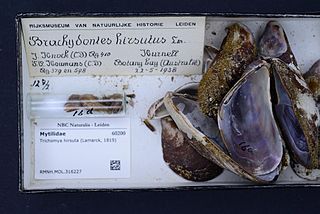
Trichomya is a monotypic genus of marine bivalve molluscs in the family Mytilidae, the mussels. The only species is Trichomya hirsuta which is endemic to southern and eastern Australia. Its common names include the hairy mussel, the greenling and the kelp greenling.

Mytilus unguiculatus, common name the Korean mussel or the hard-shelled mussel, is a species of mussel, a marine bivalve mollusc in the family Mytilidae. This species is heavily exploited as a food item via mariculture in Korea and in China. It is also a typical macrofouling organism.

Gigantidas tangaroa is a species of deep-sea mussel, a marine bivalve mollusk in the family Mytilidae, the mussels.
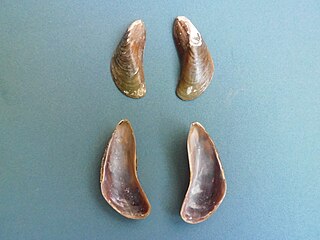
Mytella charruana is a bivalve, commonly known as the charru mussel. This species was discovered in Central and South America and by Alcide d'Orbigny, a French naturalist, in 1842. They are less than an inch long (2.5 cm), and range from brown to black in color.

Modiolus capax, common name fat horsemussel, is a species of "horse mussel", a marine bivalve mollusc in the family Mytilidae, the mussels. It was first described to science by American malacologist Timothy Abbott Conrad in 1837. The type specimen was collected in San Diego by Thomas Nuttall.

Brachidontes pharaonis is a species of mussel from the family Mytilidae. It is native to the Indian Ocean and the Red Sea, and has colonised the Mediterranean Sea where it is regarded as an invasive species.

Arcuatula senhousia, commonly known as the Asian date mussel, Asian mussel or bag mussel, is a small saltwater mussel, a marine bivalve mollusk species in the family Mytilidae, the mussels. Other common names for this species include: the Japanese mussel, Senhouse's mussel, the green mussel, and the green bagmussel. It is harvested for human consumption in China.

